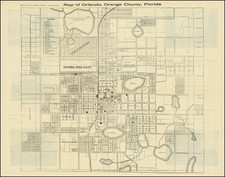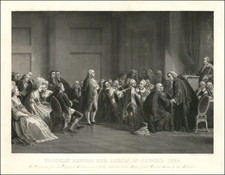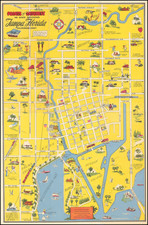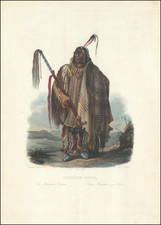Native Floridians Tilling and Planting Seeds
Fine view showing the Native Americans tilling the soil and planting. The men are shown using a type of hoe made of a fishbone on a wooden stick. The women make holes in the soil and drop in the seeds
The text translates as follows:
The Indians diligently cultivate the land; for this reason, the men have learned to prepare hoes from fish bones. To these, they fit wooden handles and easily dig the soil, as it is softer. After breaking it up well and watering it, they sow beans and millet or maize. Some go ahead and make holes in the ground with a stick, into which the bean and millet grains are inserted. After sowing, they leave the fields. For at this time, they avoid winter, which is sufficiently cold, especially in a region situated between the West and the North, and lasts about three months, specifically from December 24 to March 15. Walking naked, they hide themselves in the woods. After winter has passed, they return home, waiting for the maturity of the crop. Once the harvest is complete, they store the fruits for use throughout the year, not engaging in any trade with them unless perhaps for some trivial household item through exchange.
The engravings published by Theodor de Bry in his Grand Voyages (1591), based upon watercolor illustrations made by Jacques Le Moyne de Morgues, are the earliest known European depictions of Native Americans in what is now known as the United States. Le Moyne, a member of the short-lived French colony known as Fort Caroline founded by Huguenot explorer Rene Goulaine de Laudonniere (ca. 1529-1574), based the watercolors on his experiences in Florida in the 1560s. De Bry later published Le Moyne's work, along with other illustrations of the New World, as part of an effort to encourage European colonization in the Americas. Jacques le Moyne de Morgues, an illustrator and explorer, sailed with René de Laudonnière on the 1564 Huguenot expedition to Florida. Laudonnière set up Fort Caroline on the St. John's River in 1564, but the settlement was destroyed by the Spanish army under Pedro Menendez de Aviles.
De Bry's Engravings of the Florida Indians
For his Grands Voyages, De Bry engraved 42 plates based Le Moyne's original sketches made during the French Huguenot voyage to the Florida Peninsula. De Bry's renderings of Florida and its inhabitants are today the earliest known printed European images of Native Americans in present-day Florida, known as the Timucua Indians.
The images attempt to convey a number of messages about the land and its peoples. For example, some of the plates have been suggested to represent the ability of the Timucua to obey authority and that they are less sophisticated than the Europeans. This was argued to make them ideal candidates for French Huegonot colonization, to be used in conflicts against Catholic Spain.
The accuracy of De Bry's depictions have sometimes been called into question. Some of the engravings do not quite match what became known about the Timucua by later French explorers, and some engravings possess out-of-place features, such as the appearance of a Pacific nautilus rather than a Florida whelk shell. However, it is believed that the core of the imagery is correct. For example, the depiction of Timucuan body art, otherwise unknown to Europeans at the time, suggest that De Bry's depictions were grounded in reality.
Theodor de Bry (1528-1598) was a prominent Flemish engraver and publisher best known for his engravings of the New World. Born in Liege, de Bry hailed from the portion of Flanders then controlled by Spain. The de Brys were a family of jewelers and engravers, and young Theodor was trained in those artisanal trades.
As a Lutheran, however, his life and livelihood were threatened when the Spanish Inquisition cracked down on non-Catholics. De Bry was banished and his goods seized in 1570. He fled to Strasbourg, where he studied under the Huguenot engraver Etienne Delaune. He also traveled to Antwerp, London, and Frankfurt, where he settled with his family.
In 1590, de Bry began to publish his Les Grands Voyages, which would eventually stretch to thirty volumes released by de Bry and his two sons. The volumes contained not only important engraved images of the New World, the first many had seen of the geographic novelties, but also several important maps. He also published a collection focused on India Orientalis. Les Grands Voyages was published in German, Latin, French, and English, extending de Bry’s fame and his view of the New World.













![The North Coast of the Gulf of Mexico from St. Marks to Galveston . . . 1844 . . . Additions to 1856, including the Surveys of Comr. Powell, Lt. Simmes & Profr. Coffin, U.S. Navy [and] St. Marks to Galveston. Sheet II. . . . 1845. Additions to 1851 . . . .](https://storage.googleapis.com/raremaps/img/small/89497.jpg)
